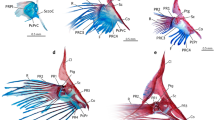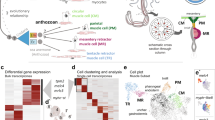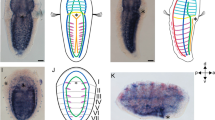Abstract
THE generally accepted view as to the origin of the musculature of the Crustacea is that it is derived from the mesoderm. In Chirocephalus, while the majority of the muscles arise from the mesoderm, there are others that are definitely of ectodermal origin. The dilator muscles of the proctodæum are examples of this type, and probably with these should be classed the dilator muscles of the sophagus. At the most posterior tip of the body, where the ectoderm folds inwards to form the proctodæal tube, the formation of the dilator muscles can be seen most clearly. Certain ectodermal cells in this region elongate and then, while retaining one end in the outer ectoderm, the other passes inwards with the invaginating ectoderm. This passage inwards is probably not an active migration, but is brought about by the proliferation of the surrounding cells, the latter pushing in between the two ends of the muscle cell. In the elongating cell body one or two fibrils appear that very early divide into segments, giving the typical structure of striped muscle. The final muscle is thus an elongated cell, attached at its inner end directly to the cuticle lining the proctodæum and at the other end to the external cuticle.
This is a preview of subscription content, access via your institution
Access options
Subscribe to this journal
Receive 51 print issues and online access
$199.00 per year
only $3.90 per issue
Buy this article
- Purchase on Springer Link
- Instant access to full article PDF
Prices may be subject to local taxes which are calculated during checkout
Similar content being viewed by others
Author information
Authors and Affiliations
Rights and permissions
About this article
Cite this article
CANNON, H. Ectodermal Muscles in a Crustacean. Nature 115, 458–459 (1925). https://doi.org/10.1038/115458a0
Issue Date:
DOI: https://doi.org/10.1038/115458a0
Comments
By submitting a comment you agree to abide by our Terms and Community Guidelines. If you find something abusive or that does not comply with our terms or guidelines please flag it as inappropriate.



